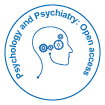Transcranial Electric Stimulation in Psychology and Psychiatry: A Tendency
Received: 13-Oct-2017 / Accepted Date: 14-Oct-2017 / Published Date: 20-Oct-2017
Editorial
At the end of the last century and beginning of the present, the application in humans of transcranial electric stimulation (tES), particularly transcranial direct current stimulation (tDCS), through procedures and protocols similar to those of today, was mainly oriented to the study of the motor system [1-4]. Since then, however, there has been a clear tendency to extend the use of this non-invasive brain stimulation tool to the study of many other brain functions [5]. It has also dramatically increased the number of scientific publications on the use of tDCS and transcranial alternating current stimulation (tACS) in Psychology and Psychiatry [6], as well as in other clinical settings [7], including paediatrics [8].
Although the most evident effects of the application of tES are still observed in motor system research, both moderate and notable behavioral and cognitive effects have also been described with different montages and protocols of tDCS and tACS. Under stimulation parameters in the range of 1-2 mA of intensity, using the most usual electrodes sizes (5 × 5 cm and 7 × 5 cm) and with durations of stimulation between 10 and 30 min, there are multiple reports on the effectiveness of tDCS to modify different cognitive and brain functions, particularly after multiple or repetitive sessions. Attentional and perceptive processes, language, memory, executive functions, motor learning, and emotion are some examples of neuropsychological and cognitive processes consistently improved or modified after application of tDCS [9]. In the context of brain pathologies or psychiatry, the results of clinical and experimental studies are even more promising. Positive effects of different procedures of tES have been found in depression and other mood disorders, autism, stroke and motor rehabilitation and/or neglect, cerebral palsy and dystonia, refractory epilepsy, chronic pain, fibromyalgia, phantom limb pain, multiple sclerosis, language and neuropsychological rehabilitation, attention-deficit/hyperactivity disorder (ADHD), tinnitus treatment, psychosis, motor control in Parkinson disease, disorders of consciousness, drug dependence, and some others disorders or pathologies, various of them both in adults [5] and children [8,10,11]. Besides, the safety of these techniques and the minimum adverse effects that are reported in clinical and basic research, encourage their use in multiple health and disease conditions [7].
This tendency to discover all the potential of tECS to induce improvements in normal and altered brain functions continues growing, and future studies could reveal further applications and utilities of these non-invasive brain stimulation techniques for therapeutic purposes and for cognitive augmentation.
References
Citation: Molero-Chamizo A, Rivera-Urbina GN (2017) Transcranial Electric Stimulation in Psychology and Psychiatry: A Tendency. Psychol Psychiatry 1: e101.
Copyright: © 2017 Molero-Chamizo A, et al. This is an open-access article distributed under the terms of the Creative Commons Attribution License, which permits unrestricted use, distribution, and reproduction in any medium, provided the original author and source are credited.
Share This Article
Open 91桃色 Journals
Article Usage
- Total views: 2524
- [From(publication date): 0-2017 - May 05, 2025]
- Breakdown by view type
- HTML page views: 1724
- PDF downloads: 800
